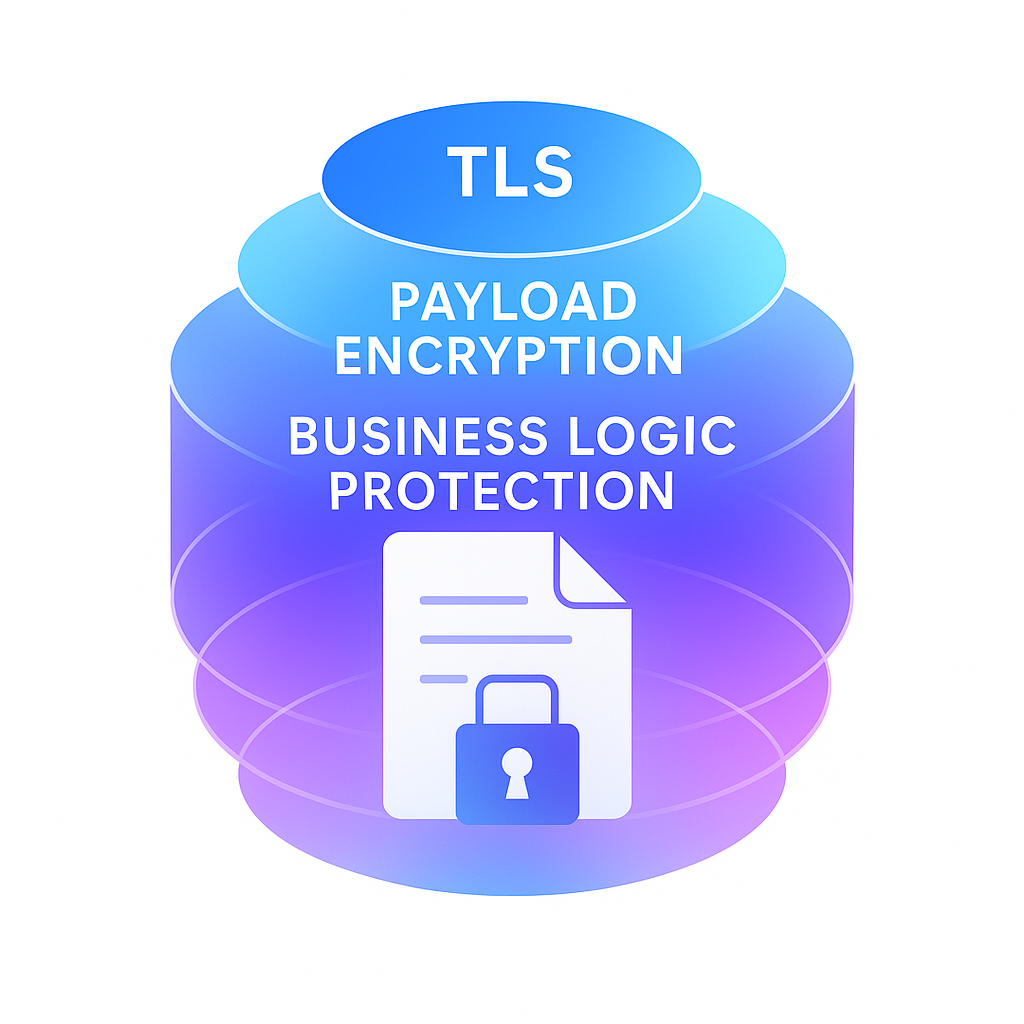
Beyond TLS: Why Modern Web Applications Need Payload-Level Encryption
Executive Summary
While Transport Layer Security (TLS) has been the standard for protecting data in transit, it no longer suffices against modern attack vectors targeting web applications and APIs. TLS encrypts communication channels but leaves application logic, request payloads, and client-side code exposed to attackers. Payload-level encryption addresses these blind spots by encrypting data at the application layer—making payloads and request paths invisible, unforgeable, and immune to interception or manipulation.
This blog explains why businesses need to go beyond TLS and adopt payload-level encryption to secure sensitive data, prevent business logic exploits, and protect against man-in-the-browser attacks. Learn how Codesealer enables scalable, proactive payload encryption, effectively shrinking your API attack surface and eliminating critical vulnerabilities before attackers can exploit them.
TLS is Not the Last Line of Defense
TLS provides encryption in transit but does nothing to secure:
- The exposed application logic (attackers can still see the API structure),
- The actual payloads once decrypted by the client or server,
- Frontend manipulations that compromise request contents before encryption,
- Replay attacks and man-in-the-browser threats.
Let’s break this down.
Visibility into API Requests
Even with TLS in place, attackers can still intercept and inspect API requests on the client side, before they’re encrypted. Tools like browser dev consoles or proxy tools (e.g., Burp Suite) allow malicious actors to read and manipulate payloads—making TLS irrelevant for what happens inside the browser or app.
Client-Side Code is Exposed
Modern single-page apps (SPAs) are shipped to the browser with complete business logic. Anyone can inspect and modify this code, making it possible to:
- Replay or forge requests,
- Discover hidden or undocumented endpoints,
- Modify request payloads with malicious values.
TLS doesn’t stop any of this. It simply wraps an insecure interaction in an encrypted envelope.
The Case for Payload-Level Encryption
Encrypting the Payload
With authenticated encryption at the application layer, the payload of each request is encrypted before it is handed to TLS. This means:
- Attackers can no longer read or tamper with the data in intercepted API calls.
- Replay attempts are detected and discarded.
- Sensitive data—credentials, PII, transactions—remain protected even if the transport layer is compromised.
Encrypting Request Paths
Payload-level encryption can also include encrypting API endpoints themselves, hiding the application structure from attackers. This prevents:
- Mapping of your application’s logic (reducing reconnaissance value),
- Targeting specific endpoints with known vulnerabilities,
- Understanding business flows that could be abused.
Defense Against Man-in-the-Browser (MitB)
Payload-level encryption ensures that even if malware exists in the user’s browser (e.g., via a malicious extension or script), the attacker cannot see or manipulate the encrypted requests without access to the key. This secures sensitive actions like transactions, updates, and data exchanges.
Why Monitoring Isn’t Enough
You might argue that WAFs, SIEMs, and API gateways can detect these anomalies—but these are reactive tools. They trigger alerts after something suspicious has occurred, and often depend on known signatures or behavior patterns.
Payload-level encryption is proactive: it stops attackers from ever seeing or touching valuable data, and it invalidates forged or replayed requests before they reach your backend.
How Codesealer Makes This Possible
Traditional payload encryption is hard to scale—it requires key management, browser integrity, and often adds latency.
Codesealer solves these challenges by:
- Deploying a secure bootloader that validates and encrypts every request from the browser,
- Establishing an end-to-end encrypted tunnel from the frontend directly to your backend APIs,
- Ensuring payloads and request paths are unreadable and unforgeable without access to Codesealer’s keys and runtime context,
- Automatically invalidating stale sessions or replay attempts.
Built for Hostile Environments
Codesealer is designed to operate even when the browser or device cannot be trusted. Attackers with full control of the browser still cannot access decrypted data, forge payloads, or reverse engineer API flows.
By eliminating visibility and interaction with the app’s internals, Codesealer effectively shuts down the attack surface that traditional TLS leaves open.
Conclusion: TLS is Table Stakes. Payload Encryption is the Future.
In an age where APIs drive business, and applications live in hostile environments, TLS isn’t enough. It’s time to move beyond TLS to protect what truly matters: the data, logic, and functionality of your application.
With Codesealer, payload-level encryption is no longer a theoretical ideal—it’s a deployable, scalable reality.
